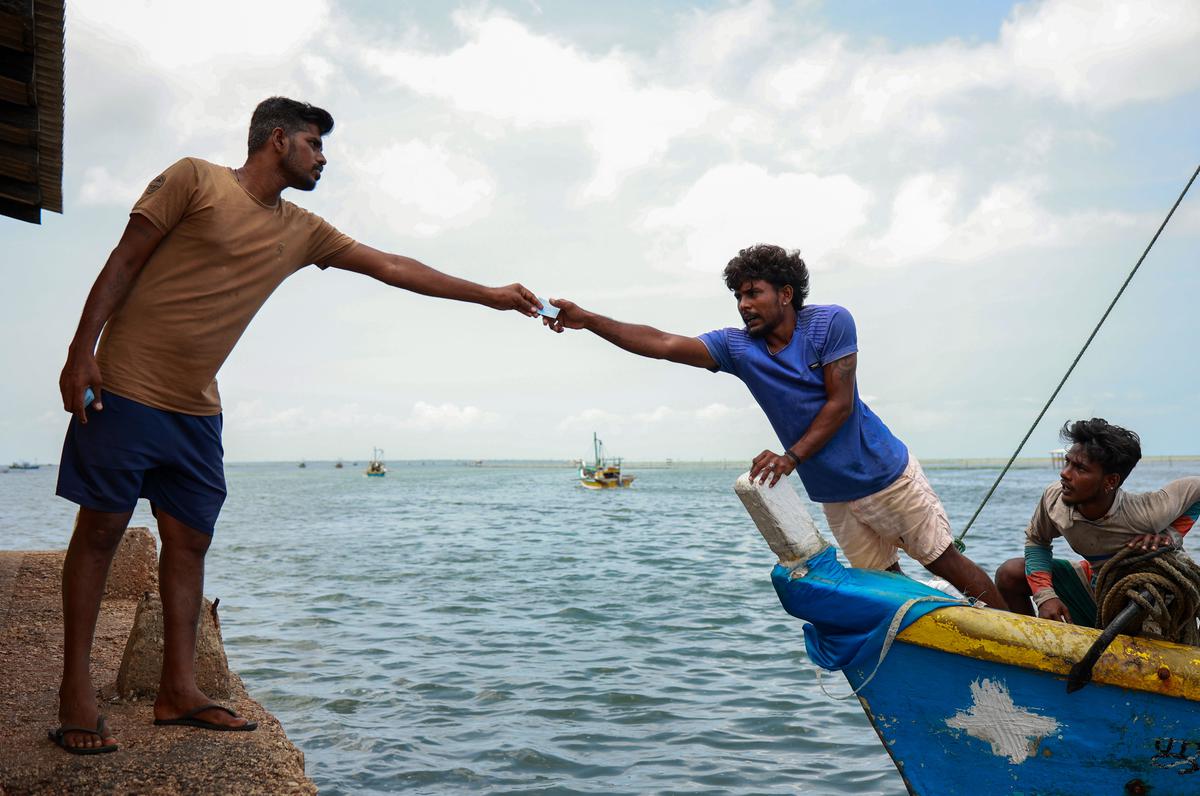The People’s Voice is Louder captures the tension of a crisis that remains fresh in the public conscience of the subcontinent
| Photo Credit: Nayanahari Abeynayake
Thousands of yellow and blue LPG cylinders are lined around the Galle International Cricket Stadium to form a worryingly long non-human queue. This is perhaps the most recognisable face of the Sri Lankan economic crisis of 2021-22, that now finds itself plastered across a partition wall, almost larger than life, at Alliance Francaise of Madras’ new gallery. Curtains of faces, drooped in desperation, are drawn on the opposite end beyond which a film plays through the day. Meanwhile, the fisherfolk of Jaffna take over one of the other walls. The blue seas and the red boats fail to mask the frustration of a community that struggled to make a living because of acute fuel shortage.
With a commendable narrative design that is hard-hitting and rightly claustrophobic, The People’s Voice is Louder captures the tension of a crisis that remains fresh in the public conscience of the subcontinent. Curated by Chennai Photo Biennale and Goethe-Institut/Max Mueller Bhavan, the exhibit spans the work of four Srilankan photographers who witnessed the crisis unfold through their varied angles, and lenses.
The images are raw, crowded, and extremely telling. The idea that sensitivity forms the cornerstone of any form of crisis documentation comes through in each frame. A diptych of black-and-white photographs by Nayanahari Abeynayake from the southern coast of the country caught in crossfire, deliberately zooms into frames, thereby avoiding any revelation of her subject’s face. Instead, an empty steel plate, a question mark, and a protest poster in the making, tangible symbols of resistance, are in focus. Another unmissable frame of hers, is an aerial shot, that shows Srilankan flags being carried by protesters in white.
Some of the captured images are literal translations of the scale of the protest — powerful images that speak volumes of the people’s revolution, chaos, noise and tension in tow. While others are subtle retellings that train the spotlight on micro-movements within the movement itself. Parilogithan Ram’s series is dedicated to such powerful micro-movements. At Galle Face Green in Colombo which quickly became ground zero for the protests, a man — visibly tired and pensive — looks right at the viewer from a shanty that seems to have closed for the day. The image, superimposed by graffiti sloganeering, is unnerving yet powerful.

The images are raw, crowded, and extremely telling
| Photo Credit:
Nayanahari Abeynayake
“During late nights, as everyone dispersed, the exhaustion was palpable. There were these little shops that sold flags, protest paraphernalia and snacks for the protestors, that were run by daily wage workers who lost their livelihoods during the time. They often stayed back even as the crowd thinned, to help if needed,” narrates Parilogithan. The superimposed graffiti, on the other hand, was taken at the Port City Project site in Colombo, a statement in itself.
A crisis also gives birth to community-driven action. Lojithan’s documentation of how the artiste community came together to contribute through song, dance and theatre at protest sites, is an unexplored, yet important facet.
Pirainila Krishnarajah on the other hand trained her lens on the fisherfolk community in Gurunagar, Jaffna. The documentary photographer who has been in the media field for 10 years realised that while protests in Colombo were being covered by the world, peripheral movements like that of the fishing community in Jaffna, did not make it to the screens. “I wanted to cover the people affected, not just the protest. The fisherfolk in Gurunagar were not able to go to sea without gasoline. As people who completely depend on daily earnings, their life stopped. For them, every single day at sea matters,” says Pirainila, who spent many days observing the community to “gauge their emotions better.” She adds, “Since they were already frustrated, it was important for me to be extremely sensitive.”

Pirainila captured the daily woes of the fishing community in Jaffna
| Photo Credit:
Pirainila Krishnarajah
Colourful boats, severed fish heads, cramped settlements, all together make up her impressive series of photographs that lend a birds-eye view into the life of a community. Lending a stark difference in perception is Riyal Riffai’s almost-journalistic coverage of the on-ground happenings in the main protest sites. Especially powerful is the image of a man, on his knees, his fists crossed in protest as others look on. This single image sets the tone to what forms the core of this display: resistance.
One year later, though the situation has turned for the better, the collective memory is fresh. “It’s almost like we are now used to it. There are apprehensions, but we get by, day by day,” concludes Parilogithan.
The People’s Voice is Louder will be on display at ESPACE24 Gallery, Alliance Francaise of Madras till July 2.